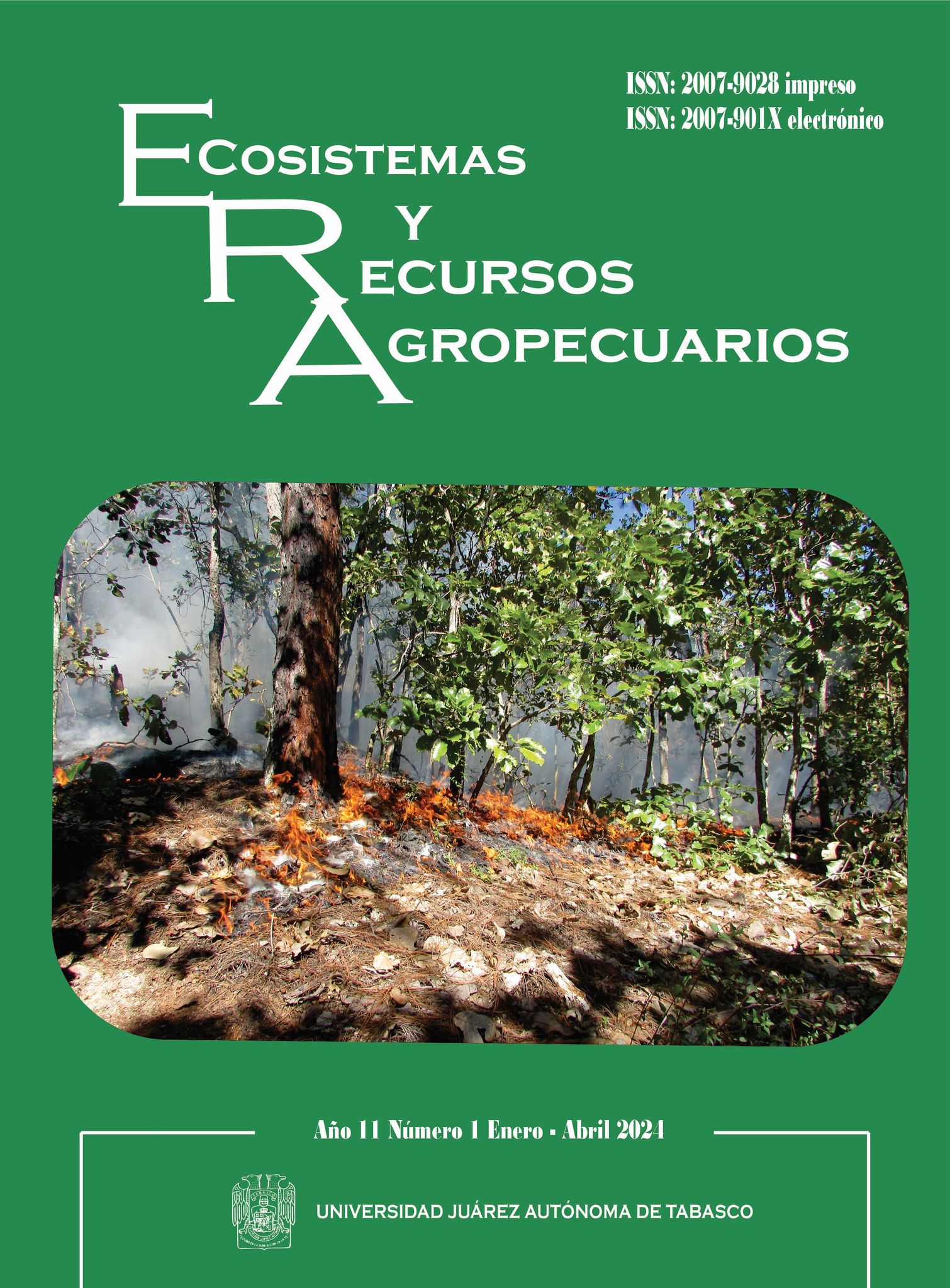Allelopathic effect of Eucalyptus globulus and Pinus halepensis litter on high Andean wild plant species, Peru
Allelopathy in high Andean wild plants, Peru.
DOI:
https://doi.org/10.19136/era.a11n1.3505Keywords:
Eucalyptus. Exotic plants. Litter leached. Pinus. Seed bank.Abstract
Invasive alien plant species cause serious impacts on the structure and functioning of invaded ecosystems, leaving native species at a disadvantage. Eucalyptus globulus and Pinus halepensis are two species characterized by their wide distribution and high competitive ability. The objective of this study was to compare the allelopathic effect of E. globulus and P. halepensis litter leachate on germination, growth and species diversity of wild high Andean plants. We collected 30 soil samples from the first 10 cm from 1 m2 quadrats. Leachate negatively affected germination, growth, and diversity of wild plant species, particularly eucalyptus leachate. As this is one of the few studies carried out in high Andean areas, it is necessary to carry out studies under natural conditions and on larger time scales, to more accurately assess the effects on biodiversity.
Downloads
References
Alonso Á, Castro-Díez P (2015) Las invasiones biológicas y su impacto en los ecosistemas: Ecosistemas 24: 1-3. https://doi.org/10.7818/ECOS.2015.24-1.01
Altamirano A, Lara A (2010) Deforestación en ecosistemas templados de la precordillera andina del centro-sur de Chile. Bosque 31: 53-64. https://doi.org/10.4067/S0717-92002010000100007
Alrababah MA, Tadros MJ, Samarah NH, Ghosheh H (2009) Allelopathic effects of Pinus halepensis and Quercus coccifera on the germination of Mediterranean crop seeds. New Forests 38: 261-272. DOI: https://doi.org/10.1007/s11056-009-9145-8
Ballester A, Arias A, Cobián B, López-Calvo E, Viéitez-Cortizo E (2011) Estudio de potenciales alelopáticos originados por “Eucalyptus globulus” Labill., “Pinus pinaster” Ait. y “Pinus radiata” D. Pastos 12: 239-254.
Bayle GK (2019) Ecological and social impacts of eucalyptus tree plantation on the environment. Journal of Biodiversity Conservation and Bioresource Management 5: 1-12. https://doi.org/10.3329/jbcbm.v5i1.42189
Becerra PI, Catford JA, Inderjit U, McLeod ML, Andonian K, Aschehoug ET, Montesinos D, Callaway RM (2018) Inhibitory effects of Eucalyptus globulus on understorey plant growth and species richness are greater in non-native regions. Global Ecology and Biogeography 27: 68-76. https://doi.org/10.1111/geb.12676
Bielinis E, Kwiatkowski J, Boiko S (2019) Identification of Pinus sylvestris clones with highest and lowest allelopathic potentials. Baltic Forestry 25: 52-58. https://doi.org/10.46490/vol25iss1pp052
Bonanomi G, Zotti M, Idbella M, Mazzoleni S, Abd-ElGawad AM (2021) Microbiota modulation of allelopathy depends on litter chemistry: Mitigation or exacerbation? Science of the Total Environment 776. https://doi.org/10.1016/j.scitotenv.2021.145942
Callaway RM, Ridenour WM (2004) Novel weapons: invasive success and the evolution of increased competitive ability. Frontiers in Ecology and the Environment 2: 436-443.
Calviño-Cancela M, van Etten EJ (2018) Invasive potential of Eucalyptus globulus and Pinus radiata into native eucalypt forests in Western Australia. Forest Ecology and Management 424: 246-258. https://doi.org/10.1016/J.FORECO.2018.05.001
Cao Y, Fu S, Zou X, Cao H, Shao Y, Zhou L (2010) Soil microbial community composition under Eucalyptus plantations of different age in subtropical China. European Journal of Soil Biology 46: 128-135. https://doi.org/10.1016/j.ejsobi.2009.12.006
Capdevila-Argüelles L, Zilletti B, Álvarez VÁ (2013) Causas de la pérdida de biodiversidad: Especies Exóticas Invasoras. 22. Memorias de La Real Sociedad Española de Historia Natural 10: 55-75.
Chu C, Mortimer PE, Wang H, Wang Y, Liu X, Yu S (2014) Allelopathic effects of Eucalyptus on native and introduced tree species. Forest Ecology and Management 323: 79-84. https://doi.org/10.1016/j.foreco.2014.03.004
Dodet M, Collet C (2012) When should exotic forest plantation tree species be considered as an invasive threat and how should we treat them? Biological invasions 14: 1765-1778. https://doi.org/10.1007/s10530-012-0202-4
Domic A, Capriles J (2009) Allometry and effects of extreme elevation on growth velocity of the Andean tree Polylepis tarapacana Philippi (Rosaceae). Plant Ecology 205: 223-234. https://doi.org/10.1007/s11258-009-9612-5
Frank D, Finckh M (1997) Impactos de las plantaciones de pino oregón sobre la vegetación y el suelo en la zona centro-
sur. Revista Chilena de Historia Natural 70: 191-211.
Gaofeng X, Shicai S, Fudou Z, Yun Z, Hisashi KN, David RC (2018) Relationship Between Allelopathic Effects and Functional Traits of Different Allelopathic Potential Rice Accessions at Different Growth Stages. Rice Science 25: 32-41. https://doi.org/10.1016/J.RSCI.2017.09.001
Gareca E, Martinez Y, Bustamante R, Aguirre L, Siles M (2007) Regeneration patterns of Polylepis subtusalbida growing
with the exotic trees Pinus radiata and Eucalyptus globulus at Parque Nacional Tunari, Bolivia. Plant Ecology
: 253-263. https://doi.org/10.1007/s11258-007-9263-3
Gil-Mora JE, Casas-Toribio SM (2023). Extracto acuoso de Eucalyptus globulus Labill. en la germinación y desarrollo de
cultivos andinos: un estudio de alelopatía en Cusco, Perú. Revista Forestal Del Perú 38: 60-80.
https://doi.org/10.21704/RFP.V38I1.1596
Guerrero P, Bustamante R (2007) Can native tree species regenerate in Pinus radiata plantations in Chile? Evidence
from field and laboratory experiments. Forest Ecology and Management 253: 97-102.
https://doi.org/10.1016/j.foreco.2007.07.006
Gutierrez IR, Becerra P (2017) The effect of native forest replacement by Pinus radiata plantations on riparian plant
communities in Chile. Plant Ecology and Diversity 10: 65-75.
https://doi.org/10.1080/17550874.2017.1294630
Haq A, Muhammad Z, Badshah L, Burni T, Ullah I (2019) Allelopathic effect of Eucalyptus camaldulensis L. on seed
germination and seedling growth of Mungbean Vigna radiata (L.) Wilczek. Pakistan Journal of Weed Science
Research 25: 251-257. https://doi.org/10.28941/25-3(2019)-7
Hamrouni L, Hanana M, Amri I, Romane E, Gargouri S, Jamoussi B (2015) Allelopathic effects of essential oils of Pinus
halepensis Miller: chemical composition and study of their antifungal and herbicidal activities. Archives of
Phytopathology and Plant Protection 48: 145-158. https://doi.org/10.1080/03235408.2014.884667
Huber A, Iroumé A, Mohr C, Frêne C (2010) Efecto de plantaciones de Pinus radiata y Eucalyptus globulus sobre el recurso agua en la Cordillera de la Costa de la región del Biobío, Chile. Bosque 31: 219-230.
https://doi.org/10.4067/S0717-92002010000300006
Kanatas P (2020) Potential role of Eucalyptus spp. and Acacia spp. allelochemicals in weed management. Chilean
journal of agricultural research 80: 452-458. https://doi.org/10.4067/S0718-58392020000300452
Karki D, Pandeya B, Ghimire B (2023) Diversity and distribution of invasive alien plant species along elevation gradient in Makawanpur district, central Nepal. Journal of Ecology and Environment 47. https://doi.org/10.5141/JEE.23.032
Inderjit, Callaway RM, Vivanco JM (2006) Plant biochemistry helps to understand invasion ecology. Trends in Plant
Science 11: 574-580.
Le-Maitre DC, Gaertner M, Marchante E, Ens EJ, Holmes PM, Pauchard A, O’Farrell PJ, Rogers AM, Blanchard R, Blignaut
J, Richardson DM (2011) Impacts of invasive Australian acacias: implications for management and restoration.
Diversity and Distributions 17: 1015-1029. https://doi.org/10.1111/J.1472-4642.2011.00816.X
Lorenzo P, González L (2010) Alelopatía: Una característica ecofisiológica que favorece la capacidad invasora de las
especies vegetales. Ecosistemas 19: 79-91. https://doi.org/10.7818/re.2014.19-1.00
Luzar J (2007) The political ecology of a “Forest Transition”: Eucalyptus forestry in the Southern Peruvian Andes. Ethnobotany Research and Applications 5: 85-93.
McCoy RM, Widhalm JR, McNickle GG (2022) Allelopathy as an evolutionary game. Plant Direct 6. https://doi.org/10.1002/pld3.382
Narwal SS (2006) Allelopathy in ecological sustainable agriculture. Allelopathy 25: 51-72. https://doi.org/10.1007/1- 4020-4280-9_24
Pan M, Lei Q, Zang N, Zhang H (2019) A Strategy Based on GC-MS/MS, UPLC-MS/MS and virtual molecular docking for analysis and prediction of bioactive compounds in Eucalyptus globulus leaves. International Journal of Molecular Sciences 20: 3875. https://doi.org/10.3390/ijms20163875.
Pinos J (2020) Challenges and conservation implications of Polylepis woodlands in the Andean region: Defining actions for sustainable management. Hacquetia 19: 143-153. https://doi.org/10.2478/hacq-2020-0001
Plett KL, Monk M, Carnegie AJ, Powell JR, Green P, Plett JM (2023) Reduced growth of Pinus radiata in the presence of the Australian native Allocasuarina nana via direct allelopathy and inhibition of the pine-supporting mycorrhizal community. Applied Soil Ecology 187. https://doi.org/10.1016/j.apsoil.2023.104852
Puig CG, Reigosa MJ, Valentão P, Andrade PB, Pedrol N (2018) Unravelling the bioherbicide potential of Eucalyptus globulus Labill: Biochemistry and effects of its aqueous extract. PLOS ONE 13(2). https://doi.org/10.1371/journal.pone.0192872
R Development Core Team. 2022. R: A language and environment for statistical computing. Vienna, Austria: R Foundation for Statistical Computing. https://www.R-project.org. Fecha de consulta: 20 de septiembre de 2022.
Rositska NV (2020) Influence of drought on allelopathic properties of Pinus sylvestris L. Plant Introduction 85/86: 41- 49. https://doi.org/10.46341/PI2019001
Santonja M, Bousquet‐Mélou A, Greff S, Ormeño E, Fernandez C (2019) Allelopathic effects of volatile organic compounds released from Pinus halepensis needles and roots. Ecology and Evolution 9: 8201-8213. https://doi.org/10.1002/ece3.5390
Senbeta F, Teketay D (2001) Regeneration of indigenous woody species under the canopies of tree plantations in Central Ethiopia. Tropical Ecology 42: 175-185.
SENAMHI (2021) Climas del Perú. Mapa de clasificación Climática Nacional. Servicio Nacional de Meteorología e Hidrología del Perú. Depósito Legal en la Biblioteca Nacional del Perú N° 2021-09410 https://www.senamhi.gob.pe/load/file/01404SENA-4.pdf. Fecha de consulta: 25 de octubre de 2022.
Souto XC, Bolaño JC, González L, Reigosa MJ (2001) Allelopathic effects of tree species on some soil microbial populations and herbaceous plants. Biología Plantarum 44: 269-275.
Stavi I, Xu C, Argaman E (2023) Climate-smart forestry in the world’s drylands: A review of challenges and opportunities. The Anthropocene Review. SAGE Publications Inc. https://doi.org/10.1177/20530196231182354
Tokgoz A, Emsen B, Dogan M (2023) Allelopathic effects of some lichens on growth and antioxidant activities of in vitro propagated Bacopa monnieri (L.) Wettst. Journal of Taibah University for Science 17. https://doi.org/10.1080/16583655.2023.2229595
Vega C, Villegas G, Rocabado P, Quezada J, López M, Quevedo A (2018) Biología reproductiva de tres especies de Polylepis (P. neglecta, P. incarum y P. pacensis), con énfasis en su comportamiento germinativo. Ecología Austral 28: 310-324. https://doi.org/10.25260/EA.18.28.1.1.703
Vilà M, Espinar JL, Hejda M, Hulme PE, Jarošík V, Maron JL, Pergl J, Schaffner U, Sun Y, Pyšek P (2011) Ecological impacts of invasive alien plants: A meta-analysis of their effects on species, communities and ecosystems. Ecology Letters 14: 702-708. https://doi.org/10.1111/j.1461-0248.2011.01628.x
Wu L, Li L, Dong P, Zhang L, Tang H, Han Y, Xie G (2023) Allelopathy of p-coumaric acid on Limnothrix sp., a bloom- forming cyanobacteria. Algal Research 103268. https://doi.org/10.1016/j.algal.2023.103268
Downloads
Published
Issue
Section
License
Copyright (c) 2024 Ecosistemas y Recursos Agropecuarios

This work is licensed under a Creative Commons Attribution-NonCommercial-ShareAlike 4.0 International License.
Aviso de copyright
Los autores que se envían a esta revista aceptan los siguientes términos:
una. Los autores conservan los derechos de autor y garantizan a la revista el derecho a ser la primera publicación del trabajo con una licencia de atribución de Creative Commons que permite a otros compartir el trabajo con un reconocimiento de la autoría del trabajo y la publicación inicial en esta revista.
B. Los autores pueden establecer acuerdos complementarios separados para la distribución no exclusiva de la versión del trabajo publicado en la revista (por ejemplo, en un repositorio institucional o publicarlo en un libro), con un reconocimiento de su publicación inicial en esta revista.
C. Se permite y se anima a los autores a difundir su trabajo electrónicamente (por ejemplo, en repositorios institucionales o en su propio sitio web) antes y durante el proceso de envío, ya que puede conducir a intercambios productivos, así como a una cita más temprana y más extensa del trabajo publicado. (Consulte El efecto del acceso abierto).


